Integrated Ecological Security Assessment: Coupling Risk, Health, and Ecosystem Services in Headwater Regions—A Case Study of the Yangtze and Yellow River Source
Abstract
1. Introduction
- (1)
- Theoretical completeness, integrating ecological risks, system stability, and service provision capacity for a comprehensive evaluation from structure to function;
- (2)
- Regional adaptability, constructing an evaluation system tailored to the ecological baseline characteristics of high-altitude fragile regions, incorporating specific indicators such as water retention and permafrost degradation;
- (3)
- Methodological integration, utilizing spatial statistical models and geographically weighted regression to achieve multi-source data fusion and multi-scale analysis.
2. Materials and Methods
2.1. Study Area
2.2. Data Collection and Preprocessing
2.3. Methods
2.3.1. Ecological Risk Assessment Model
2.3.2. Ecosystem Health Assessment Model
2.3.3. Ecosystem Services Assessment Model
2.3.4. Assessment System for Ecological Security
2.3.5. Spatial Autocorrelation
2.3.6. Geographic Detector
3. Results and Analysis
3.1. Temporal Dynamics
3.2. Spatial Distribution Analysis
3.3. Spatial Autocorrelation
3.4. Attribution Analysis
4. Discussion
4.1. Spatiotemporal Variations in Ecological Security
4.2. Ecological Security Drivers
4.3. Limitations
5. Conclusions
- (1)
- ESI exhibited an initial increase followed by a decline, with 2010 marking a critical turning point, after which it continued to decrease, falling below the 2000 level by 2020.
- (2)
- The rising ERI significantly weakened both ESI and ESsI, with this effect becoming particularly pronounced after 2010.
- (3)
- Spatially, the Local Indicators of Spatial Association (LISA) analysis revealed a gradient of ecological security, declining from high-security core areas in the east to low-security zones in the west, closely associated with topography and elevation. Notably, no linear or monotonic relationship was observed between areas of significant ESI variation and permafrost degradation zones.
- (4)
- The geographical detector model identified vegetation coverage (X5) as a primary driver of ESI spatial heterogeneity, playing a central role in mediating the combined regulation of climate and topographic factors on ecological security.
Supplementary Materials
Author Contributions
Funding
Data Availability Statement
Acknowledgments
Conflicts of Interest
Abbreviations
| ESI | Ecological Security Index |
| ERI | Ecological Risk Index |
| EHI | Ecosystem Health Index |
| ESsI | Ecosystem Service Index |
| SRYY | Source Region of Yangtze and Yellow Rivers |
| NDVI | Normalized Difference Vegetation Index |
| HAILS | Human Activity Intensity on Land Surfaces |
| FVC | Fractional Vegetation Cover |
| SPEI | Standardized Precipitation Evapotranspiration Index |
References
- Immerzeel, W.W.; Van Beek, L.P.; Bierkens, M.F. Climate change will affect the Asian water towers. Science 2010, 328, 1382–1385. [Google Scholar] [CrossRef]
- Yao, T.; Thompson, L.; Yang, W.; Yu, W.; Gao, Y.; Guo, X.; Yang, X.; Duan, K.; Zhao, H.; Xu, B.; et al. Different glacier status with atmospheric circulations in Tibetan Plateau and surroundings. Nat. Clim. Change 2012, 2, 663–667. [Google Scholar] [CrossRef]
- Shen, Y.; Chen, Y. Global perspective on hydrology, water balance, and water resources management in arid basins. Hydrol. Process. Int. J. 2010, 24, 129–135. [Google Scholar] [CrossRef]
- Cui, L.; Zhao, Y.; Liu, J.; Han, L.; Ao, Y.; Yin, S. Landscape ecological risk assessment in Qinling Mountain. Geol. J. 2018, 53, 342–354. [Google Scholar] [CrossRef]
- Roveri, G.; Crespi, A.; Eisendle, F.; Rauch, S.; Corradini, P.; Steger, S.; Zebisch, M.; Strapazzon, G. Climate change and human health in Alpine environments: An interdisciplinary impact chain approach understanding today’s risks to address tomorrow’s challenges. BMJ Glob. Health 2024, 8, e014431. [Google Scholar] [CrossRef]
- Cheng, G.; Wu, T. Responses of permafrost to climate change and their environmental significance, Qinghai-Tibet Plateau. J. Geophys. Res. Earth Surf. 2007, 112, 1–10. [Google Scholar] [CrossRef]
- Yang, M.; Nelson, F.E.; Shiklomanov, N.I.; Guo, D.; Wan, G. Permafrost degradation and its environmental effects on the Tibetan Plateau: A review of recent research. Earth-Sci. Rev. 2010, 103, 31–44. [Google Scholar] [CrossRef]
- Kang, S.; Xu, Y.; You, Q.; Flügel, W.-A.; Pepin, N.; Yao, T. Review of climate and cryospheric change in the Tibetan Plateau. Environ. Res. Lett. 2010, 5, 015101. [Google Scholar] [CrossRef]
- Wang, G.; Li, Y.; Wang, Y.; Wu, Q. Effects of permafrost thawing on vegetation and soil carbon pool losses on the Qinghai–Tibet Plateau, China. Geoderma 2008, 143, 143–152. [Google Scholar] [CrossRef]
- Yi, S.; Zhou, Z.; Ren, S.; Xu, M.; Qin, Y.; Chen, S.; Ye, B. Effects of permafrost degradation on alpine grassland in a semi-arid basin on the Qinghai–Tibetan Plateau. Environ. Res. Lett. 2011, 6, 045403. [Google Scholar] [CrossRef]
- Niu, F.; Lin, Z.; Liu, H.; Lu, J. Characteristics of thermokarst lakes and their influence on permafrost in Qinghai–Tibet Plateau. Geomorphology 2011, 132, 222–233. [Google Scholar] [CrossRef]
- Zhang, Y.; Wang, G.; Wang, Y. Changes in alpine wetland ecosystems of the Qinghai–Tibetan plateau from 1967 to 2004. Environ. Monit. Assess. 2011, 180, 189–199. [Google Scholar] [CrossRef]
- Cuo, L.; Zhang, Y.; Zhu, F.; Liang, L. Characteristics and changes of streamflow on the Tibetan Plateau: A review. J. Hydrol. Reg. Stud. 2014, 2, 49–68. [Google Scholar] [CrossRef]
- Su, B.; Huang, J.; Zeng, X.; Gao, C.; Jiang, T. Impacts of climate change on streamflow in the upper Yangtze River basin. Clim. Change 2017, 141, 533–546. [Google Scholar] [CrossRef]
- Li, W.; Wu, J.; Bai, E.; Jin, C.; Wang, A.; Yuan, F.; Guan, D. Response of terrestrial carbon dynamics to snow cover change: A meta-analysis of experimental manipulation (II). Soil Biol. Biochem. 2016, 103, 388–393. [Google Scholar] [CrossRef]
- Yang, H.; Mu, S.; Li, J. Effects of ecological restoration projects on land use and land cover change and its influences on territorial NPP in Xinjiang, China. CATENA 2014, 115, 85–95. [Google Scholar] [CrossRef]
- Zhang, L.; Guo, H.; Ji, L.; Lei, L.; Wang, C.; Yan, D.; Li, B.; Li, J. Vegetation greenness trend (2000 to 2009) and the climate controls in the Qinghai-Tibetan Plateau. J. Appl. Remote Sens. 2013, 7, 073572. [Google Scholar] [CrossRef]
- Zhou, J.-R.; Li, X.-Q.; Yu, X.; Zhao, T.-C.; Ruan, W.-X. Exploring the ecological security evaluation of water resources in the Yangtze River Basin under the background of ecological sustainable development. Sci. Rep. 2024, 14, 15475. [Google Scholar] [CrossRef] [PubMed]
- Du, Z.; Ji, X.; Zhao, W.; Jiang, J.; He, Z.; Liu, H.; Gao, J.; Wang, X. Integrating revised DPSIR and ecological security patterns to assess the health of alpine grassland ecosystems on the Qinghai-Tibet Plateau. Sci. Total Environ. 2024, 957, 177833. [Google Scholar] [CrossRef]
- Liang, L.; Li, L.; Liu, C.; Cuo, L. Climate change in the Tibetan Plateau Three Rivers Source Region: 1960–2009. Int. J. Climatol. 2013, 33, 2900. [Google Scholar] [CrossRef]
- Shen, M.; Piao, S.; Jeong, S.-J.; Zhou, L.; Zeng, Z.; Ciais, P.; Chen, D.; Huang, M.; Jin, C.-S.; Li, L.Z. Evaporative cooling over the Tibetan Plateau induced by vegetation growth. Proc. Natl. Acad. Sci. USA 2015, 112, 9299–9304. [Google Scholar] [CrossRef] [PubMed]
- Wang, Z.; Wu, J.; Niu, B.; He, Y.; Li, J. Vegetation expansion on the Tibetan Plateau and its relationship with climate change. Remote Sens. 2020, 12, 4150. [Google Scholar] [CrossRef]
- Qi, Y.; Lian, X.; Wang, H.; Zhang, J.; Yang, R. Dynamic mechanism between human activities and ecosystem services: A case study of Qinghai lake watershed, China. Ecol. Indic. 2020, 117, 106528. [Google Scholar] [CrossRef]
- Jiang, C.; Zhang, L. Ecosystem change assessment in the Three-river Headwater Region, China: Patterns, causes, and implications. Ecol. Eng. 2016, 93, 24–36. [Google Scholar] [CrossRef]
- Liu, Y.; Liu, H.; Chen, Y.; Gang, C.; Shen, Y. Quantifying the contributions of climate change and human activities to vegetation dynamic in China based on multiple indices. Sci. Total Environ. 2022, 838, 156553. [Google Scholar] [CrossRef]
- Peng, Q.; Wang, R.; Jiang, Y.; Zhang, W.; Liu, C.; Zhou, L. Soil erosion in Qilian Mountain National Park: Dynamics and driving mechanisms. J. Hydrol. Reg. Stud. 2022, 42, 101144. [Google Scholar] [CrossRef]
- Xia, L.; Bi, R.; Song, X.; Lv, C. Dynamic changes in soil erosion risk and its driving mechanism: A case study in the Loess Plateau of China. Eur. J. Soil Sci. 2021, 72, 1312–1331. [Google Scholar] [CrossRef]
- Han, Z.; Song, W.; Deng, X.; Xu, X. Grassland ecosystem responses to climate change and human activities within the Three-River Headwaters region of China. Sci. Rep. 2018, 8, 9079. [Google Scholar] [CrossRef]
- Li, P.; Chen, J.; Zhao, G.; Holden, J.; Liu, B.; Chan, F.K.S.; Hu, J.; Wu, P.; Mu, X. Determining the drivers and rates of soil erosion on the Loess Plateau since 1901. Sci. Total Environ. 2022, 823, 153674. [Google Scholar] [CrossRef]
- Zhu, Q.; Cai, Y. Integrating ecological risk, ecosystem health, and ecosystem services for assessing regional ecological security and its driving factors: Insights from a large river basin in China. Ecol. Indic. 2023, 155, 110954. [Google Scholar] [CrossRef]
- Costanza, R.; De Groot, R.; Braat, L.; Kubiszewski, I.; Fioramonti, L.; Sutton, P.; Farber, S.; Grasso, M. Twenty years of ecosystem services: How far have we come and how far do we still need to go? Ecosyst. Serv. 2017, 28, 1–16. [Google Scholar] [CrossRef]
- Yao, T.; Bolch, T.; Chen, D.; Gao, J.; Immerzeel, W.; Piao, S.; Su, F.; Thompson, L.; Wada, Y.; Wang, L.; et al. The imbalance of the Asian water tower. Nat. Rev. Earth Environ. 2022, 3, 618–632. [Google Scholar] [CrossRef]
- Ma, T.; Zhao, L.; She, Y.; Hu, B.; Feng, X.; Gongbao, J.; Zhang, W.; Zhao, Z. Identifying the Driving Forces of Alpine Wetland Dynamic Changes in the Yellow River Source National Park from 2000 to 2020. Water 2023, 15, 2557. [Google Scholar] [CrossRef]
- Jin, X.; Jin, H.; Iwahana, G.; Marchenko, S.S.; Luo, D.; Li, X.; Liang, S. Impacts of climate-induced permafrost degradation on vegetation: A review. Adv. Clim. Change Res. 2021, 12, 29–47. [Google Scholar] [CrossRef]
- Schuur, E.A.; Mack, M.C. Ecological response to permafrost thaw and consequences for local and global ecosystem services. Annu. Rev. Ecol. Evol. Syst. 2018, 49, 279–301. [Google Scholar] [CrossRef]
- Jin, X.; Jin, H.; Luo, D.; Sheng, Y.; Wu, Q.; Wu, J.; Wang, W.; Huang, S.; Li, X.; Liang, S. Impacts of permafrost degradation on hydrology and vegetation in the source area of the Yellow River on Northeastern Qinghai-Tibet Plateau, Southwest China. Front. Earth Sci. 2022, 10, 845824. [Google Scholar] [CrossRef]
- Zhou, H.; Zhao, X.; Tang, Y.; Gu, S.; Zhou, L. Alpine grassland degradation and its control in the source region of the Yangtze and Yellow Rivers, China. Grassl. Sci. 2005, 51, 191–203. [Google Scholar] [CrossRef]
- Xia, J.; Li, Z.; Zeng, S.; He, Y.; Wang, Y. Perspectives on eco-water security and sustainable development in the Yangtze River Basin. Geosci. Lett. 2021, 8, 18. [Google Scholar] [CrossRef]
- Hu, Y.; Maskey, S.; Uhlenbrook, S. Trends in temperature and rainfall extremes in the Yellow River source region, China. Clim. Change 2012, 110, 403–429. [Google Scholar] [CrossRef]
- Hou, J.; Chen, J.; Zhang, K.; Zhou, G.; You, H.; Han, X. Temporal and Spatial Variation Characteristics of Carbon Storage in the Source Region of the Yellow River Based on InVEST and GeoSoS-FLUS Models and Its Response to Different Future Scenarios. Environ. Sci. 2022, 43, 5253–5262. [Google Scholar] [CrossRef]
- Wei, D.; Feng, A.; Wu, M. Analysis of the resources value of Three-River-Source National Park based on ecological civilization. Int. J. Geoheritage Parks 2020, 8, 173–184. [Google Scholar] [CrossRef]
- Fu, M.; Tian, J.; Ren, Y.; Li, J.; Liu, W.; Zhu, Y. Functional zoning and space management of Three-River-Source National Park. J. Geogr. Sci. 2019, 29, 2069–2084. [Google Scholar] [CrossRef]
- Zhang, Q.; Miao, C.; Su, J.; Gou, J.; Hu, J.; Zhao, X.; Xu, Y. A new high-resolution multi-drought-index dataset for mainland of China. Earth Syst. Sci. Data 2025, 17, 837–853. [Google Scholar] [CrossRef]
- Li, Y.; Qin, Q.; Wang, D.; An, W.; He, X.; Yu, T. An analysis on the spatial heterogeneity characteristics of landscape ecological risk in Qilian Mountain National Park. Front. For. Glob. Change 2024, 7, 1308154. [Google Scholar] [CrossRef]
- Wei, W.; Zhao, J.; Wang, X. Landscape heterogeneity of land use types in Shiyang River basin. Chin. J. Ecol. 2010, 29, 760–765. [Google Scholar]
- Peng, J.; Liu, Y.; Wu, J.; Lv, H.; Hu, X. Linking ecosystem services and landscape patterns to assess urban ecosystem health: A case study in Shenzhen City, China. Landsc. Urban Plan. 2015, 143, 56–68. [Google Scholar] [CrossRef]
- Xu, W.; He, M.; Meng, W.; Zhang, Y.; Yun, H.; Lu, Y.; Huang, Z.; Mo, X.; Hu, B.; Liu, B. Temporal-spatial change of China’s coastal ecosystems health and driving factors analysis. Sci. Total Environ. 2022, 845, 157319. [Google Scholar] [CrossRef]
- Jia, T.; Hu, X.; Yang, H. Spatial response of habitat quality to climate change and human activities: Taking the Qinghai-Xizang Plateau as an example. J. Soil Water Conserv. 2024, 38, 203–211. [Google Scholar] [CrossRef]
- Shamuxi, A.; Han, B.; Jin, X.; Wusimanjiang, P.; Abudukerimu, A.; Chen, Q.; Zhou, H.; Gong, M. Spatial pattern and driving mechanisms of dryland landscape ecological risk: Insights from an integrated geographic detector and machine learning model. Ecol. Indic. 2025, 172, 113305. [Google Scholar] [CrossRef]
- Lupton, R.C.; Allwood, J.M. Hybrid Sankey diagrams: Visual analysis of multidimensional data for understanding resource use. Resour. Conserv. Recycl. 2017, 124, 141–151. [Google Scholar] [CrossRef]
- Yang, C.; Deng, W.; Yuan, Q.; Zhang, S. Changes in landscape pattern and an ecological risk assessment of the Changshagongma Wetland Nature Reserve. Front. Ecol. Evol. 2022, 10, 843714. [Google Scholar] [CrossRef]
- Li, X.; Li, S.; Zhang, Y.; O’Connor, P.; Zhang, L.; Yan, J. Landscape ecological risk assessment under multiple indicators. Land 2021, 10, 739. [Google Scholar] [CrossRef]
- Zhang, S.; Zhou, Y.; Yu, Y.; Li, F.; Zhang, R.; Li, W. Using the geodetector method to characterize the spatiotemporal dynamics of vegetation and its interaction with environmental factors in the qinba mountains, China. Remote Sens. 2022, 14, 5794. [Google Scholar] [CrossRef]
- Yao, B.; Gong, X.; Li, Y.; Li, Y.; Lian, J.; Wang, X. Spatiotemporal variation and GeoDetector analysis of NDVI at the northern foothills of the Yinshan Mountains in Inner Mongolia over the past 40 years. Heliyon 2024, 10, e39309. [Google Scholar] [CrossRef] [PubMed]
- Zhai, G.; Ren, P.; Zhang, R.; Wang, B.; Zhang, M.; He, T.; Zhang, J. Evaluation of land ecological security and driving factors in the Lower Yellow River Flood Plain based on quality, structure and function. Sci. Rep. 2025, 15, 2674. [Google Scholar] [CrossRef]
- Yao, T.; Thompson, L.G.; Mosbrugger, V.; Zhang, F.; Ma, Y.; Luo, T.; Xu, B.; Yang, X.; Joswiak, D.R.; Wang, W.; et al. Third Pole Environment (TPE). Environ. Dev. 2012, 3, 52–64. [Google Scholar] [CrossRef]
- Hua, T.; Zhao, W.; Pereira, P. Opinionated Views on Grassland Restoration Programs on the Qinghai-Tibetan Plateau. Front. Plant Sci. 2022, 13, 861200. [Google Scholar] [CrossRef] [PubMed]
- Liu, J.; Xu, X.; Shao, Q. Grassland degradation in the “three-river headwaters” region, Qinghai province. J. Geogr. Sci. 2008, 18, 259–273. [Google Scholar] [CrossRef]
- Wang, X.; Siegert, F.; Zhou, A.-G.; Franke, J. Glacier and glacial lake changes and their relationship in the context of climate change, Central Tibetan Plateau 1972–2010. Glob. Planet. Change 2013, 111, 246–257. [Google Scholar] [CrossRef]
- Jiang, W.; Lv, J.; Wang, C.; Chen, Z.; Liu, Y. Marsh wetland degradation risk assessment and change analysis: A case study in the Zoige Plateau, China. Ecol. Indic. 2017, 82, 316–326. [Google Scholar] [CrossRef]
- Shen, G.; Yang, X.; Jin, Y.; Xu, B.; Zhou, Q. Remote sensing and evaluation of the wetland ecological degradation process of the Zoige Plateau Wetland in China. Ecol. Indic. 2019, 104, 48–58. [Google Scholar] [CrossRef]
- Baho, D.L.; Allen, C.R.; Garmestani, A.S.; Fried-Petersen, H.B.; Renes, S.E.; Gunderson, L.H.; Angeler, D.G. A quantitative framework for assessing ecological resilience. Ecol. Soc. 2017, 22, 1–17. [Google Scholar] [CrossRef] [PubMed]
- Yu, H.; Zhang, X.; Deng, Y. Spatiotemporal Evolution and Influencing Factors of Landscape Ecological Vulnerability in the Three-River-Source National Park Region. Chin. Geogr. Sci. 2022, 32, 852–866. [Google Scholar] [CrossRef]
- Xiao, R.; Liu, Y.; Fei, X.; Yu, W.; Zhang, Z.; Meng, Q. Ecosystem health assessment: A comprehensive and detailed analysis of the case study in coastal metropolitan region, eastern China. Ecol. Indic. 2019, 98, 363–376. [Google Scholar] [CrossRef]
- Jiang, F.; Liu, C.; Zhao, J.; Jiang, B.; Fan, F. Habitat quality assessment on the Qinghai-Tibet plateau across vegetation ecoregions using InVEST and Geodetector models. Front. Earth Sci. 2024, 12, 1432434. [Google Scholar] [CrossRef]
- Jia, W.; Wang, M.; Zhou, C.; Yang, Q. Analysis of the spatial association of geographical detector-based landslides and environmental factors in the southeastern Tibetan Plateau, China. PLoS ONE 2021, 16, e0251776. [Google Scholar] [CrossRef]
- Wang, G.; Peng, W.; Zhang, L.; Zhang, J. Quantifying the impacts of natural and human factors on changes in NPP using an optimal parameters-based geographical detector. Ecol. Indic. 2023, 155, 111018. [Google Scholar] [CrossRef]
- Xu, J.; Chen, J.; Liu, Y.; Fan, F. Identification of the geographical factors influencing the relationships between ecosystem services in the Belt and Road region from 2010 to 2030. J. Clean. Prod. 2020, 275, 124153. [Google Scholar] [CrossRef]
- Polasky, S.; Nelson, E.; Pennington, D.; Johnson, K.A. The Impact of Land-Use Change on Ecosystem Services, Biodiversity and Returns to Landowners: A Case Study in the State of Minnesota. Environ. Resour. Econ. 2011, 48, 219–242. [Google Scholar] [CrossRef]
- Dybas, C.L. Where Have All the Caribou Gone? Population viability analysis may offer answers. BioScience 2012, 62, 862–866. [Google Scholar] [CrossRef]
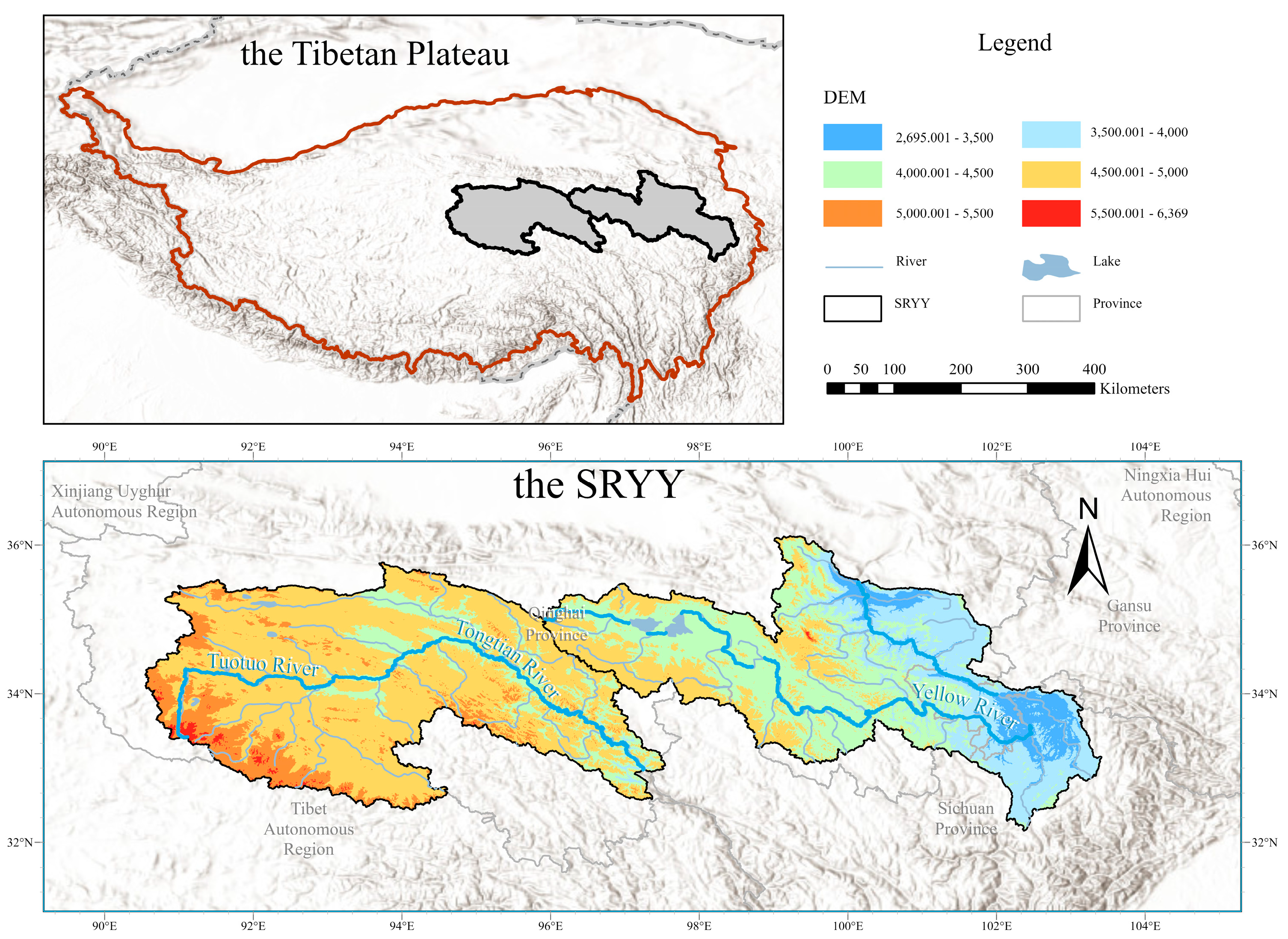
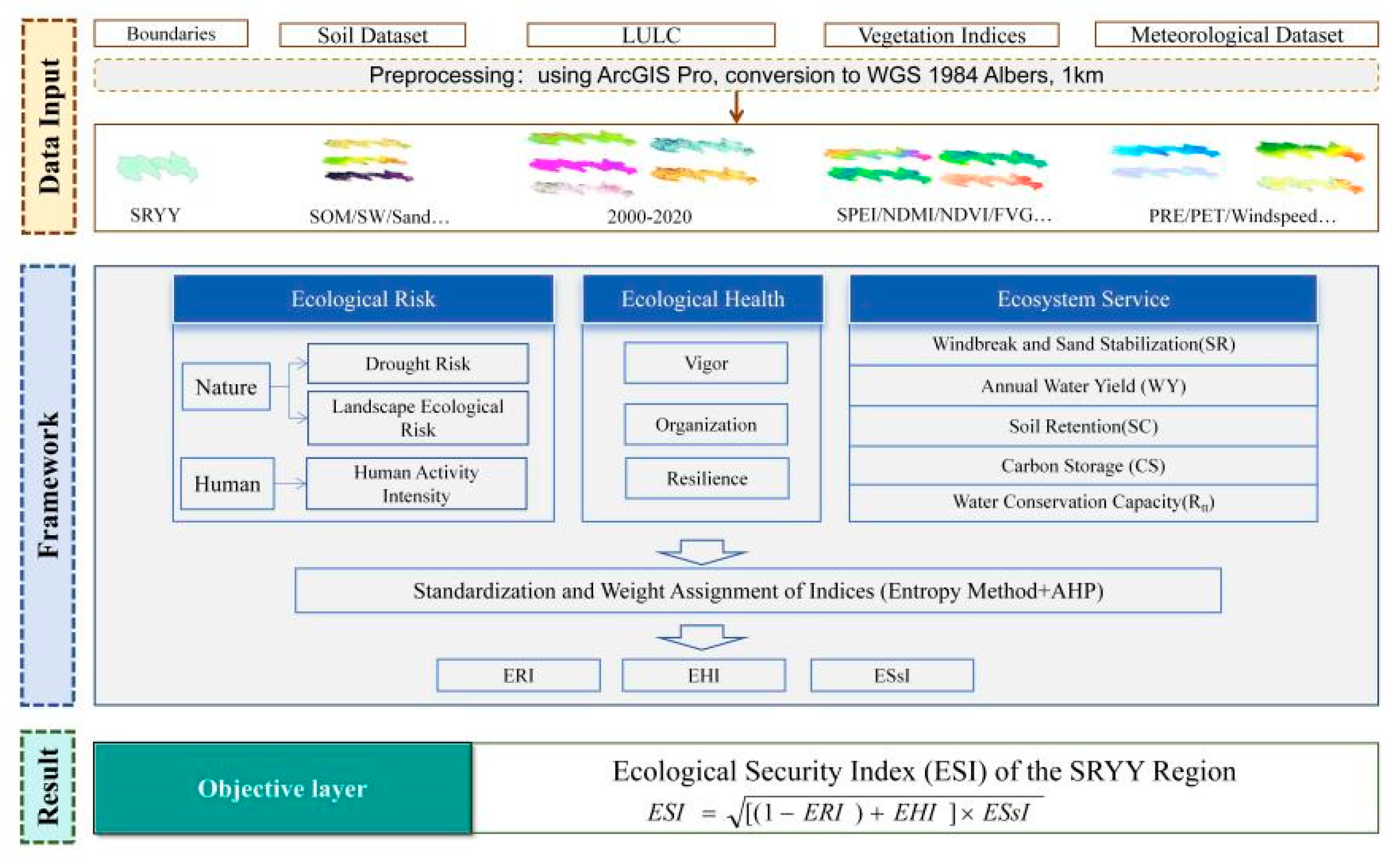
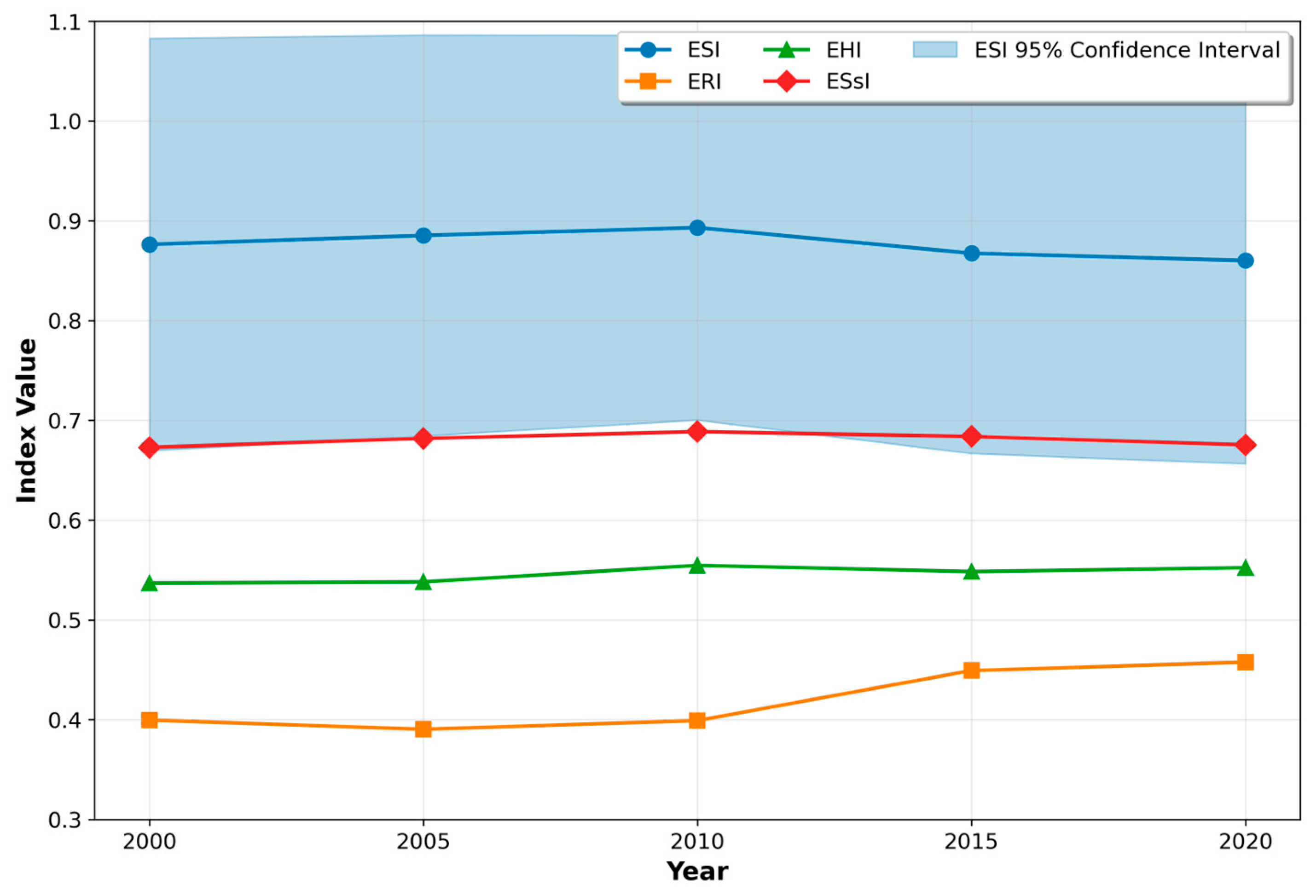
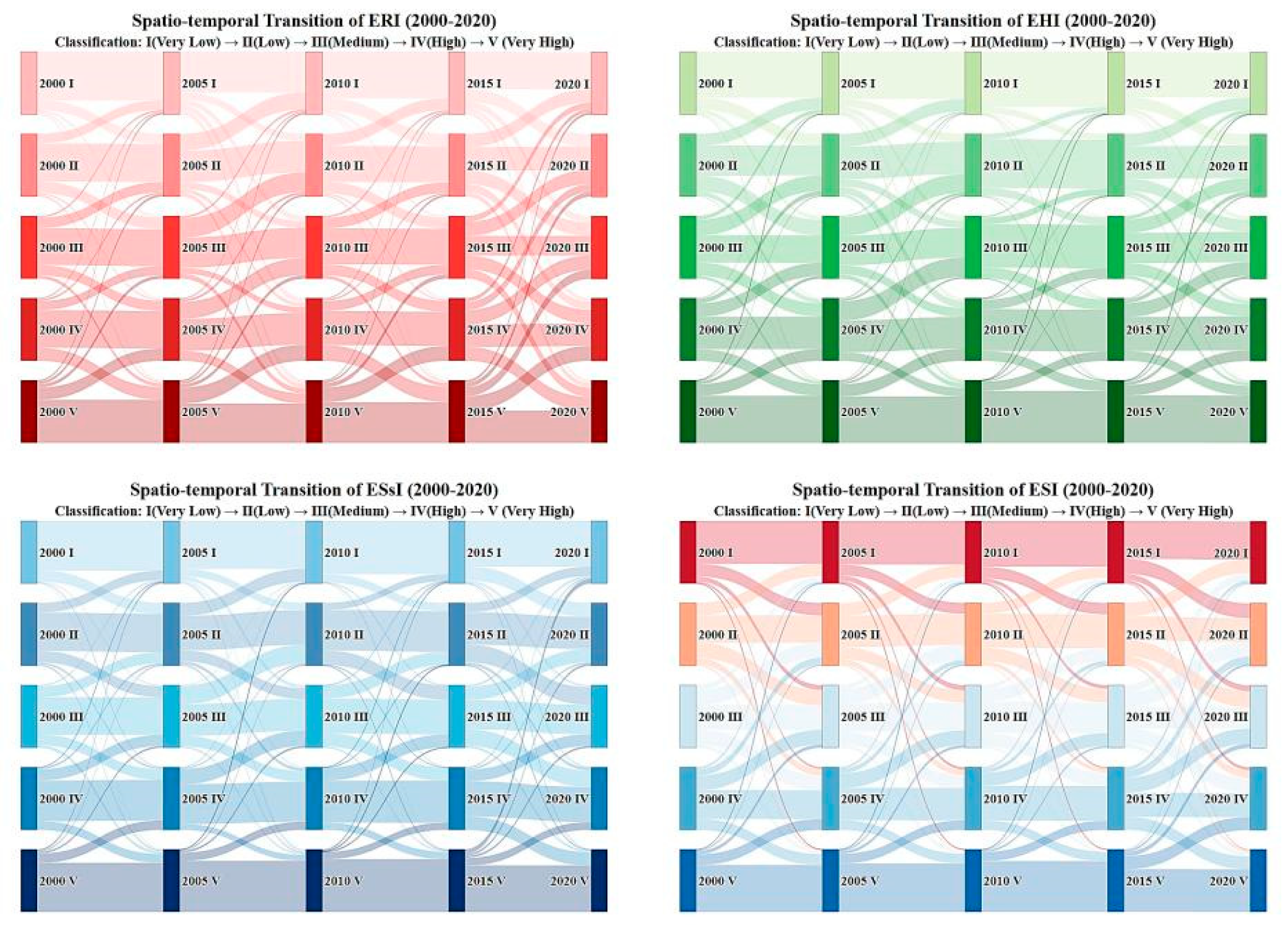
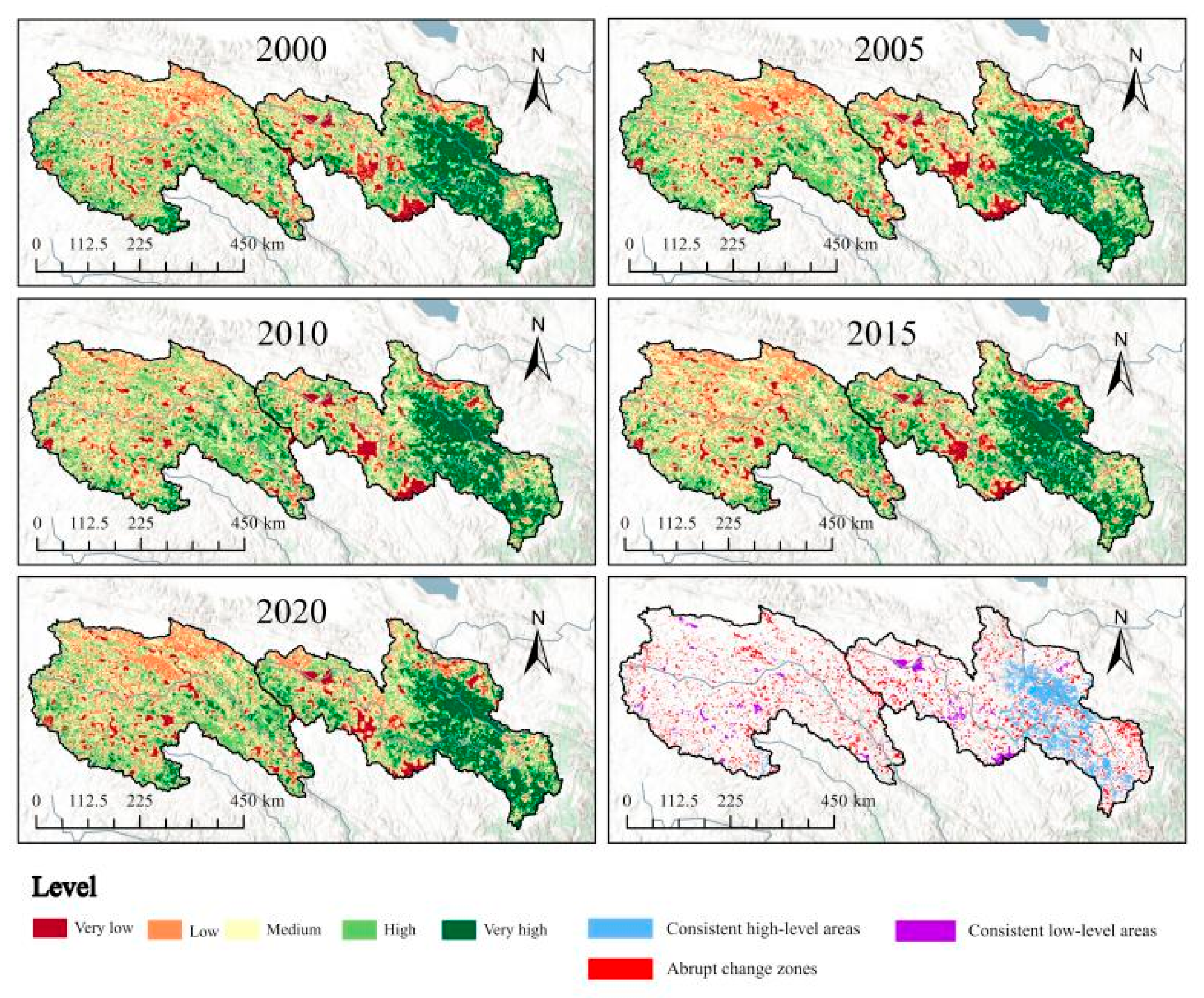

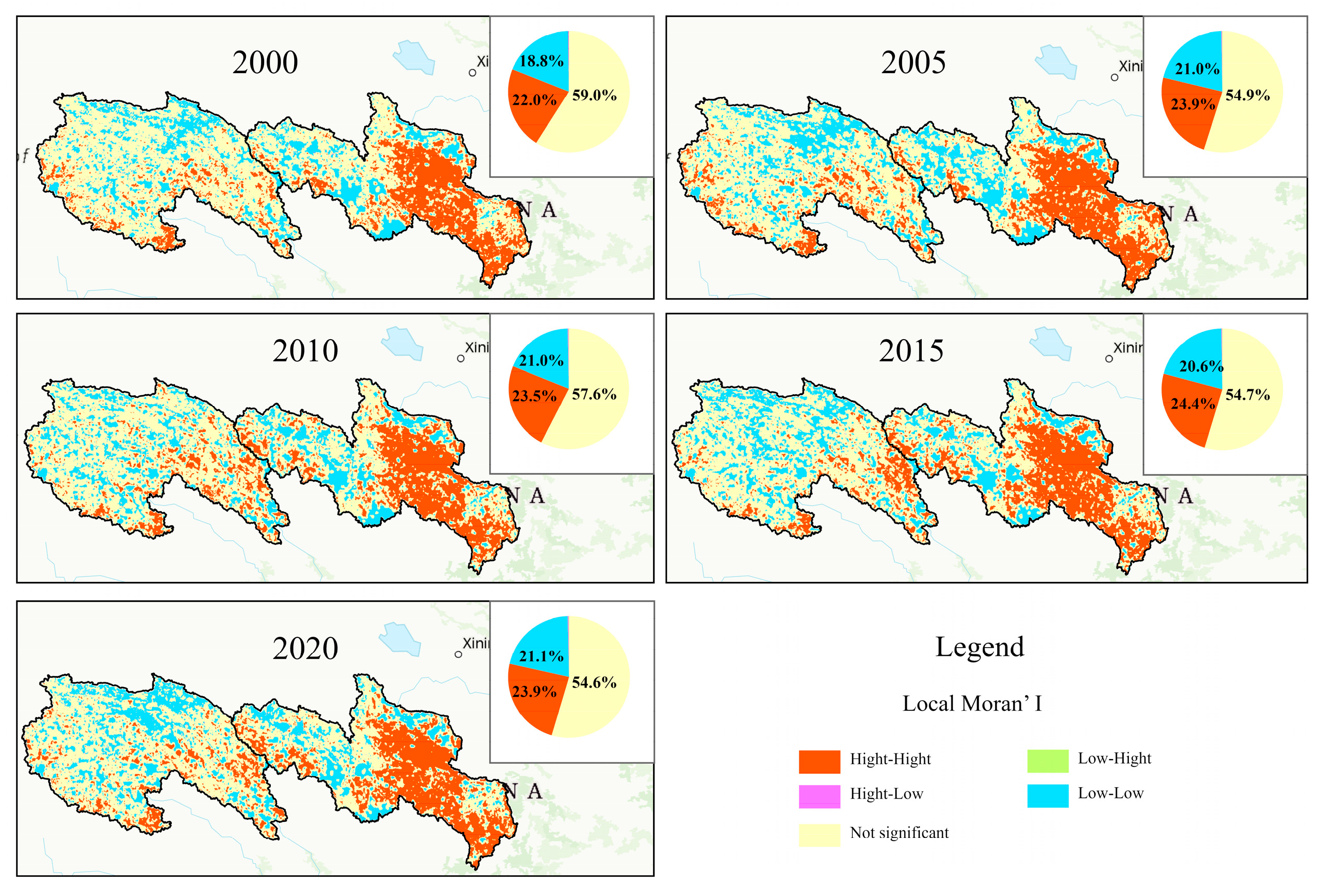
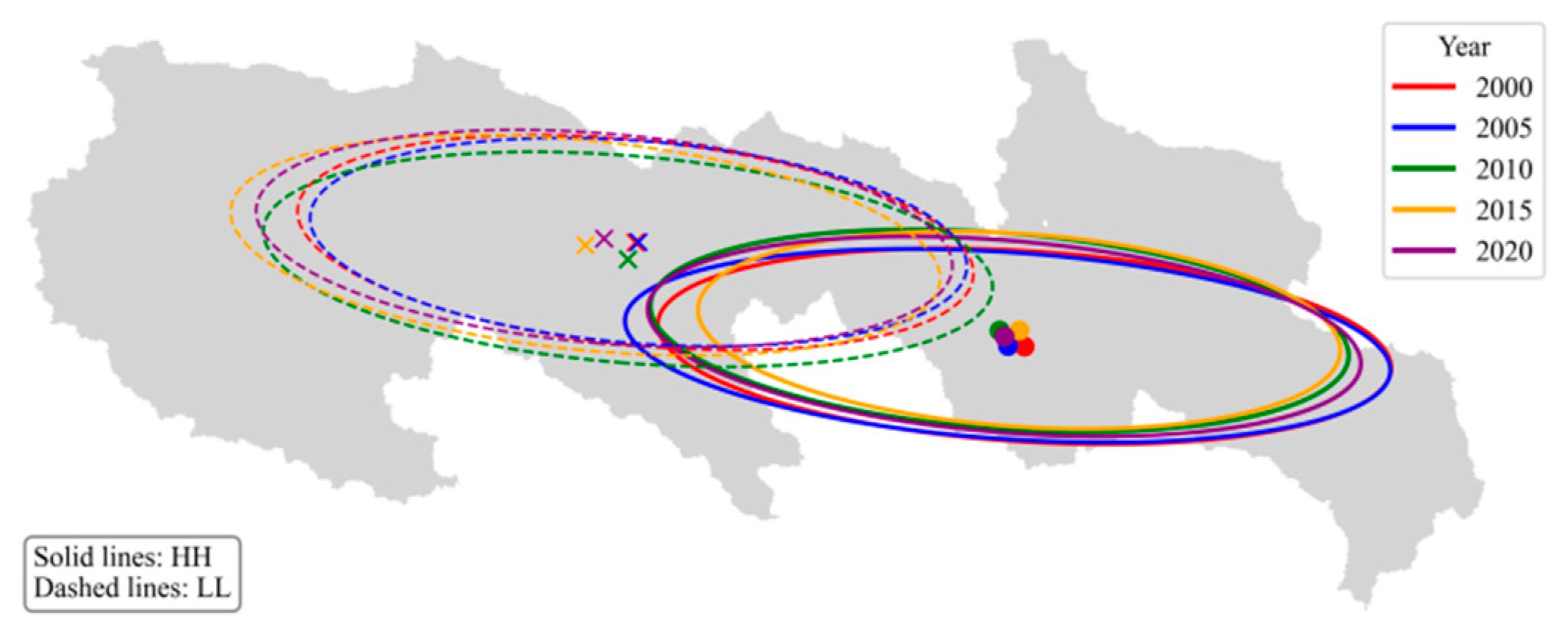
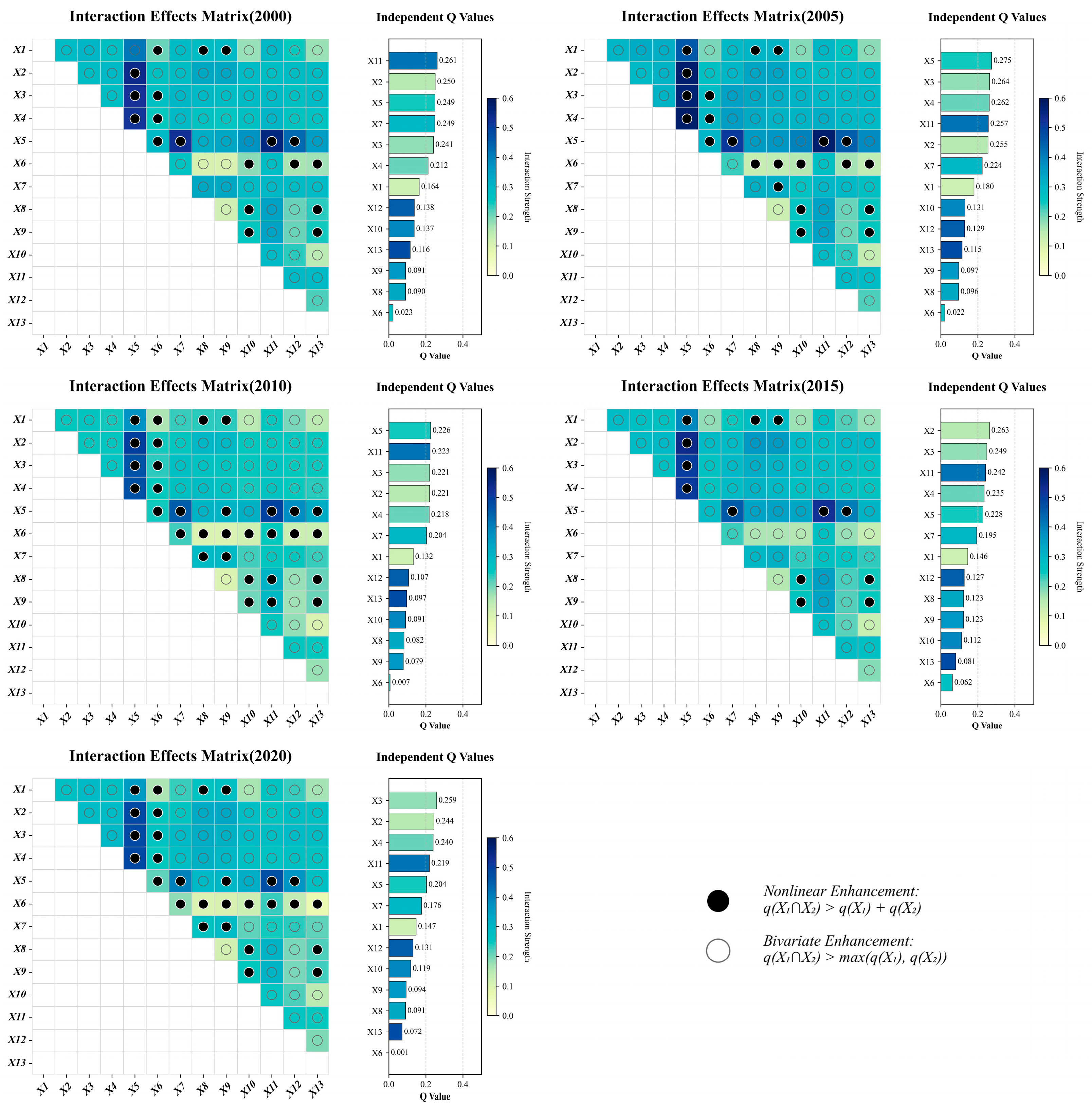
| Data Category | Specific Data & Indicators | Data Source/Processing Method |
|---|---|---|
| Vegetation Data | NDVI, NDMI | Calculated from LANDSAT 5 & 8 optical bands via Google Earth Engine for years 2000–2020, 30 m |
| Leaf Area Index (LAI) | Derived from MODIS/006/MCD12Q1 product’s LC_Type3 band for years 2000–2020, 500 m | |
| Vegetation Coverage | National Tibetan Plateau Data Center (https://data.tpdc.ac.cn, accessed on 15 April 2025) for years 2000–2020, 250 m | |
| Soil Data | Soil Organic Matter, Soil Texture | China Soil Dataset (v1.1) based on HWSD (http://www.ncdc.ac.cn, accessed on 18 April 2025) for years 2000–2020, 1 km |
| Soil Moisture | National Tibetan Plateau Data Center (https://data.tpdc.ac.cn, accessed on 20 April 2025) for years 2000–2020, 500 m | |
| Meteorological Data | Wind Speed, Snow Cover | Calculated using the ERA5 dataset in Google Earth Engine for years 2000–2020, 1 km |
| Precipitation, Potential Evapotranspiration | China Meteorological Data Network (http://data.cma.cn/, accessed on 25 April 2025) for years 2000–2020, 1 km | |
| SPEI | Provided by the team of Miao at Beijing Normal University [43] for years 2000–2020, 1 km | |
| Land Use Data | Land Use Type (6 categories, 22 subcategories) | China Multi-Period Land Use Remote Sensing Monitoring Dataset (CNLUCC) (www.resdc.cn, accessed on 11 April 2025) for years 2000, 2005, 2010, 2015, 2020, 30 m |
| Ecosystem Service Functions | Formulas | Explanation |
|---|---|---|
| Windbreak and Sand Stabilization (SR) | SR, SL, and Sp are expressed in units of t/(km2·a). Sp and Qmaxp denote the potential sand transport quantity and maximum transport capacity respectively, while S and Qmax represent the actual sand transport quantity and maximum transport capacity, all measured in kg/m (kilograms per meter). The parameter z indicates the maximum wind erosion occurrence distance (m). WF (Climatic Factor). EF (Soil Erodibility Factor). SCF (Soil Crusting Factor). RS (Surface Roughness Factor). C (Vegetation Cover Factor). | |
| Annual Water Yield (WY) | WYi: Annual water yield in evaluation unit i (mm/a). PREi: Annual precipitation in unit I (mm/a). AETi: Annual actual evapotranspiration in unit i (mm/a). | |
| Carbon Storage (CS) | Cabove: Aboveground biomass carbon stock (t). Cbelow: Belowground biomass carbon stock (t). Csoil: Soil organic carbon stock (t). Cdead: Dead organic matter carbon stock (t). | |
| Soil Retention (SC) | RKLS and USLE represent the potential soil erosion and actual soil erosion, respectively, with units of metric tons (t). R: Rainfall erosivity factor (MJ·mm/(ha·h·a)). K: Soil erodibility factor (t·ha·h/(ha·MJ·mm)). LS: Slope length and steepness factor (dimensionless). C: Vegetation cover and management factor (dimensionless). P: Conservation practice factor (dimensionless). | |
| Water Conservation Capacity (Rtt) | TI: Topographic index (dimensionless), reflecting terrain-driven water accumulation. Ksat: Soil saturated hydraulic conductivity (mm/h). Velocity: Surface runoff velocity coefficient (m/s). WY: Water yield (mm/a). |
| Category | Indicator | Variable |
|---|---|---|
| Topographic | DEM | X1 |
| Slope | X2 | |
| Surface Roughness | X3 | |
| Vegetation | LAI (Leaf Area Index) | X4 |
| FVC (Fractional Vegetation Cover) | X5 | |
| NAMI (Net Aboveground Mass Index) | X6 | |
| NDVI (Normalized Difference Vegetation Index) | X7 | |
| Meteorological | PET (Potential Evapotranspiration) | X8 |
| P (Precipitation) | X9 | |
| TMP (Temperature) | X10 | |
| SWI (Soil Water Index) | X11 | |
| Soil | Soil Hydraulic Conductivity | X12 |
| Landscape | Landscape Heterogeneity | X13 |
Disclaimer/Publisher’s Note: The statements, opinions and data contained in all publications are solely those of the individual author(s) and contributor(s) and not of MDPI and/or the editor(s). MDPI and/or the editor(s) disclaim responsibility for any injury to people or property resulting from any ideas, methods, instructions or products referred to in the content. |
© 2025 by the authors. Licensee MDPI, Basel, Switzerland. This article is an open access article distributed under the terms and conditions of the Creative Commons Attribution (CC BY) license (https://creativecommons.org/licenses/by/4.0/).
Share and Cite
Li, Z.; Xu, J.; Yuan, Z.; Wang, L. Integrated Ecological Security Assessment: Coupling Risk, Health, and Ecosystem Services in Headwater Regions—A Case Study of the Yangtze and Yellow River Source. Water 2025, 17, 2834. https://doi.org/10.3390/w17192834
Li Z, Xu J, Yuan Z, Wang L. Integrated Ecological Security Assessment: Coupling Risk, Health, and Ecosystem Services in Headwater Regions—A Case Study of the Yangtze and Yellow River Source. Water. 2025; 17(19):2834. https://doi.org/10.3390/w17192834
Chicago/Turabian StyleLi, Zhiyi, Jijun Xu, Zhe Yuan, and Li Wang. 2025. "Integrated Ecological Security Assessment: Coupling Risk, Health, and Ecosystem Services in Headwater Regions—A Case Study of the Yangtze and Yellow River Source" Water 17, no. 19: 2834. https://doi.org/10.3390/w17192834
APA StyleLi, Z., Xu, J., Yuan, Z., & Wang, L. (2025). Integrated Ecological Security Assessment: Coupling Risk, Health, and Ecosystem Services in Headwater Regions—A Case Study of the Yangtze and Yellow River Source. Water, 17(19), 2834. https://doi.org/10.3390/w17192834





